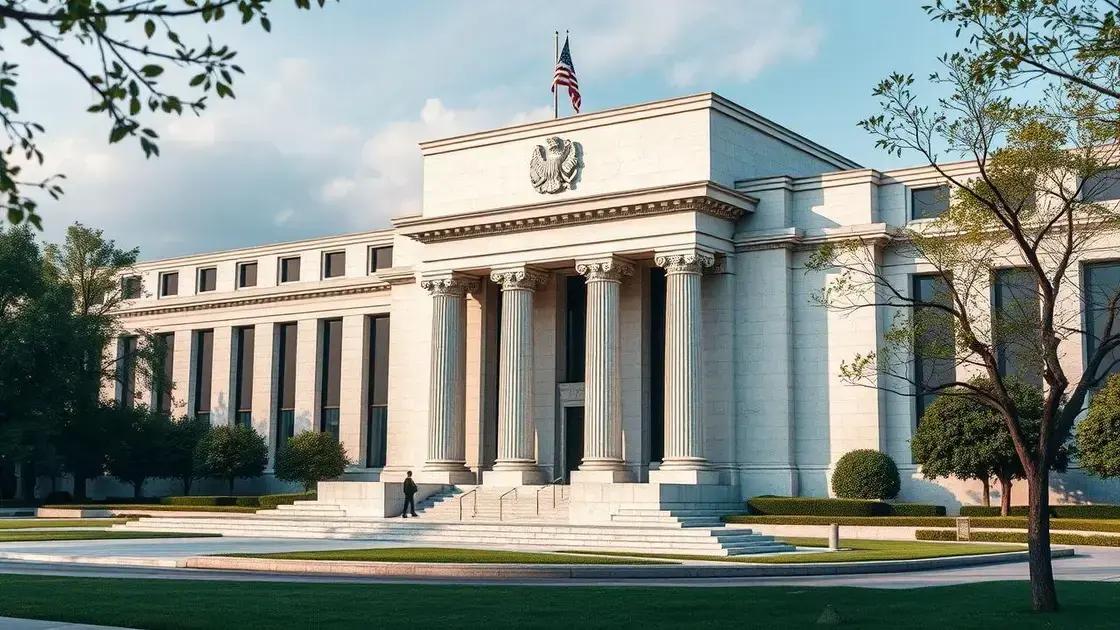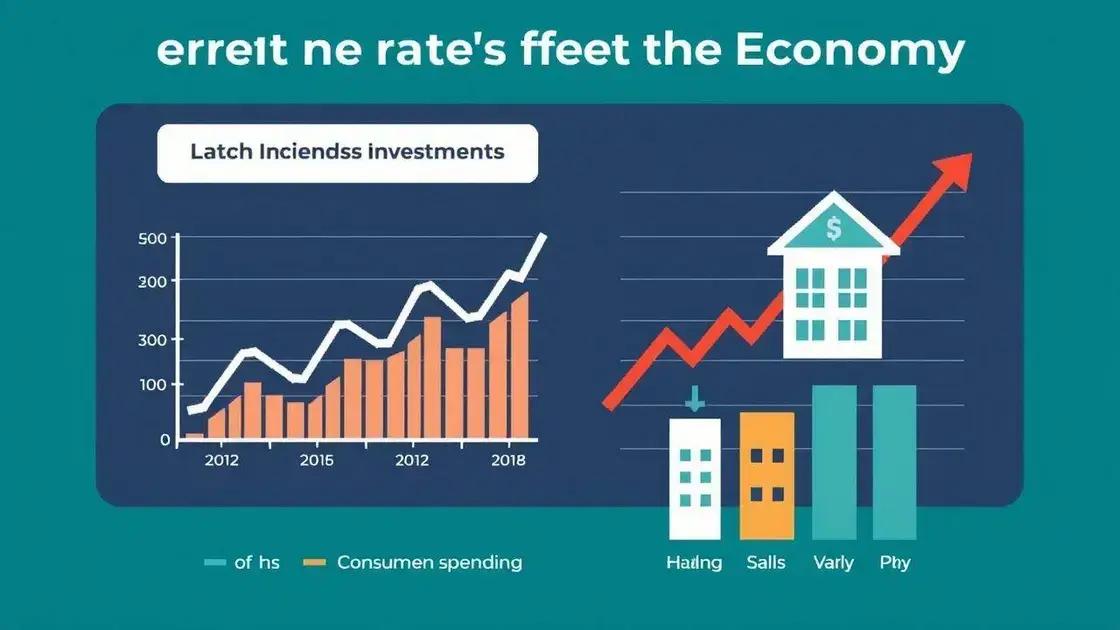Role of the Federal Reserve in economic stability

The Federal Reserve plays a vital role in economic stability by adjusting interest rates, implementing monetary policies, and responding to financial crises while adapting to future challenges like digital currency and climate change.
The role of the Federal Reserve in economic stability is often overlooked, yet it significantly impacts our daily lives. Ever wondered how changes in interest rates can affect your wallet or job security? Let’s dive into how the Fed operates and its importance.
Understanding the Federal Reserve’s mission
Understanding the Federal Reserve’s mission is essential for grasping how our economy functions. The Fed plays a crucial role in maintaining economic stability in the United States. Its primary objectives include promoting maximum employment, stabilizing prices, and fostering a sound financial system.
Promoting Maximum Employment
One of the key goals of the Federal Reserve is to ensure that everyone who wants to work can find a job. The Fed closely monitors economic indicators, like unemployment rates, to make informed decisions. When the economy is struggling, it may implement policies to spur growth.
Stabilizing Prices
Price stability is vital for economic health. The Federal Reserve aims to keep inflation in check, which means prices don’t rise too quickly. This stability helps consumers and businesses make better financial decisions. The Fed uses interest rates to control inflation; when inflation is high, it may raise rates to cool off spending.
Fostering a Sound Financial System
Another mission of the Federal Reserve is to ensure a stable and secure financial system. This involves regulating banks and financial institutions. By setting rules for these entities, the Fed helps prevent financial crises that can have widespread impacts.
- Maintaining oversight of banks.
- Implementing policies to support economic growth.
- Responding to unforeseen financial challenges.
The Federal Reserve also conducts research to inform its decisions. It analyzes trends in the economy, which helps the Fed to understand and predict changes. By doing so, the Fed can adjust its policies to meet its mission more effectively.
Through its various functions, the Federal Reserve strives to create a stable economic environment. Its mission directly influences how businesses operate and how consumers spend. A sound understanding of these processes is invaluable for anyone looking to grasp the intricate workings of our economy.
Key tools used by the Federal Reserve
The key tools used by the Federal Reserve play a vital role in shaping economic policy. These tools help the Fed manage the economy and maintain financial stability. Understanding how these tools work can provide insight into how monetary policy affects our daily lives.
Open Market Operations
One of the primary tools is open market operations. This involves buying and selling government securities. When the Fed buys securities, it injects money into the economy, promoting spending and investment. Conversely, selling these securities takes money out, which can slow down inflation.
Federal Funds Rate
The federal funds rate is another crucial tool. This rate is the interest rate at which banks lend to one another overnight. By adjusting this rate, the Fed influences borrowing costs for consumers and businesses. A lower rate encourages borrowing and spending, while a higher rate can cool off an overheated economy.
- Lowering rates can stimulate economic growth.
- Raising rates helps control inflation.
- Changes in this rate also influence mortgage and loan rates.
Reserve requirements are important as well. These are the minimum amounts of money that banks must hold in reserve. By changing these requirements, the Fed can directly affect how much money banks can lend to consumers and businesses. When reserve requirements are low, banks can lend more, stimulating the economy.
Another tool used by the Federal Reserve is the discount rate. This is the interest rate charged to commercial banks for short-term loans from the Fed. By adjusting the discount rate, the Fed can influence how much banks borrow, which impacts overall lending in the economy. Lowering the discount rate typically encourages banks to borrow more, leading to increased lending and investment.
Understanding these tools reveals how the Federal Reserve works behind the scenes to manage our economy. Each tool has a specific purpose and impact, demonstrating the Fed’s active role in influencing economic conditions.
The impact of interest rates on the economy

The impact of interest rates on the economy is significant and multifaceted. When the Federal Reserve adjusts interest rates, it influences consumer behavior and business investment decisions. Higher interest rates can lead to more expensive loans, which may discourage borrowing and spending.
Consumer Spending
When interest rates rise, consumers often face higher costs for mortgages, car loans, and credit cards. This can lead to reduced consumer spending. With less disposable income available, families may cut back on purchases, affecting overall economic growth.
Business Investment
Similarly, businesses may find it more costly to finance expansion when interest rates are high. This can result in delayed investments in new projects or equipment. On the other hand, lower interest rates encourage businesses to borrow more, fostering innovation and growth.
- Increased borrowing leads to more job creation.
- Lower rates can boost economic activity.
- Higher consumer confidence often follows lower rates.
The relationship between interest rates and inflation is another key factor. When interest rates are low, inflation often rises as demand increases. Conversely, high rates can dampen inflation. The Fed closely monitors this relationship, adjusting rates to maintain price stability while promoting growth.
Furthermore, changes in interest rates can also affect the stock market. Higher rates might lead to lower stock prices, as investors anticipate reduced corporate profits. Conversely, lower rates can entice investors to move money into equities, seeking better returns.
Understanding the impact of interest rates is crucial for anyone interested in the economy. The direct effects on consumer behavior, business investments, and overall economic health show how interconnected these elements are, making interest rates a powerful tool for economic management.
How the Fed responds to economic crises
Understanding how the Fed responds to economic crises is crucial for grasping its role in maintaining economic stability. The Federal Reserve has various strategies to address economic downturns and prevent financial systems from collapsing. When crises arise, swift action is essential to restore confidence in the economy.
Emergency Lending Programs
One of the Fed’s primary responses is through emergency lending programs. During financial crises, the Fed can provide loans to banks and other financial institutions to ensure they have enough funds to operate. This helps maintain liquidity in the financial system and prevents a credit crunch.
Lowering Interest Rates
Another significant response is lowering interest rates. By decreasing the federal funds rate, the Fed makes borrowing cheaper. This encourages consumers and businesses to borrow and spend, stimulating economic activity. When people buy more, it can help lift the economy out of a recession.
- Lower loan rates promote consumer spending.
- Businesses may invest in growth during low-rate periods.
- Cheaper mortgages can encourage home purchases.
Quantitative easing (QE) is another tool used in times of crisis. This involves purchasing large amounts of government and mortgage-backed securities to inject money into the economy. QE aims to lower long-term interest rates, making it easier for consumers to borrow and spend.
In addition to these methods, the Fed communicates with the public and markets to manage expectations. Clear communication about its strategies helps build confidence. When people understand the Fed’s actions, they may feel more secure, which can stabilize financial markets.
Understanding how the Fed responds to economic crises illustrates its critical role in maintaining financial stability. The combination of emergency lending, lower interest rates, quantitative easing, and effective communication is essential for navigating turbulent economic waters.
The future of the Federal Reserve’s role
The future of the Federal Reserve’s role is a topic of great interest as economic conditions evolve. As new challenges arise, including fluctuating inflation and technological changes, the Fed must adapt its strategies. Understanding these potential changes helps clarify how the Fed will continue to influence economic stability.
Adapting to Technology
As technology advances, the Fed faces new opportunities and challenges. Digital currencies and advancements in payment systems are changing how money moves. The Fed is exploring the implications of Central Bank Digital Currencies (CBDCs). These currencies could enhance payment efficiency and security.
Addressing Climate Change
Climate change is becoming a critical concern for central banks. The Federal Reserve may enhance its focus on how financial risks related to climate can impact the economy. By considering these factors, the Fed can promote sustainable economic growth.
- Monitoring climate-related financial risks.
- Incorporating sustainability into monetary policy decisions.
- Supporting green investments through policy initiatives.
The Fed’s commitment to financial stability will remain strong. As it navigates these changes, it will likely continue to implement policies aimed at strengthening the overall economy. The core functions of monitoring inflation, managing employment levels, and fostering economic growth will endure.
As the economic landscape shifts, the Federal Reserve must remain responsive. Future challenges will require innovative solutions, while its fundamental mission will still drive decision-making. Keeping pace with global trends will be key for the Fed’s role in the years to come.
FAQ – Frequently Asked Questions about the Role of the Federal Reserve
What is the main purpose of the Federal Reserve?
The main purpose of the Federal Reserve is to maintain economic stability, control inflation, and support maximum employment.
How do interest rates affect my daily life?
Interest rates influence borrowing costs for loans, mortgages, and credit cards, affecting how much money consumers can spend.
What actions does the Fed take during an economic crisis?
During an economic crisis, the Fed may lower interest rates, implement emergency lending programs, and use quantitative easing to stimulate the economy.
How is the Fed preparing for future economic challenges?
The Federal Reserve is adapting to challenges like digital currencies and climate change by considering new strategies and policies to maintain stability.





